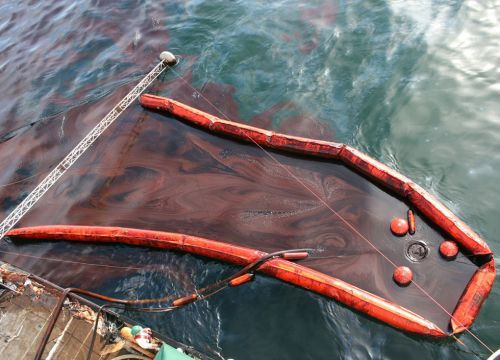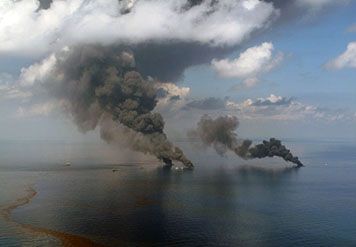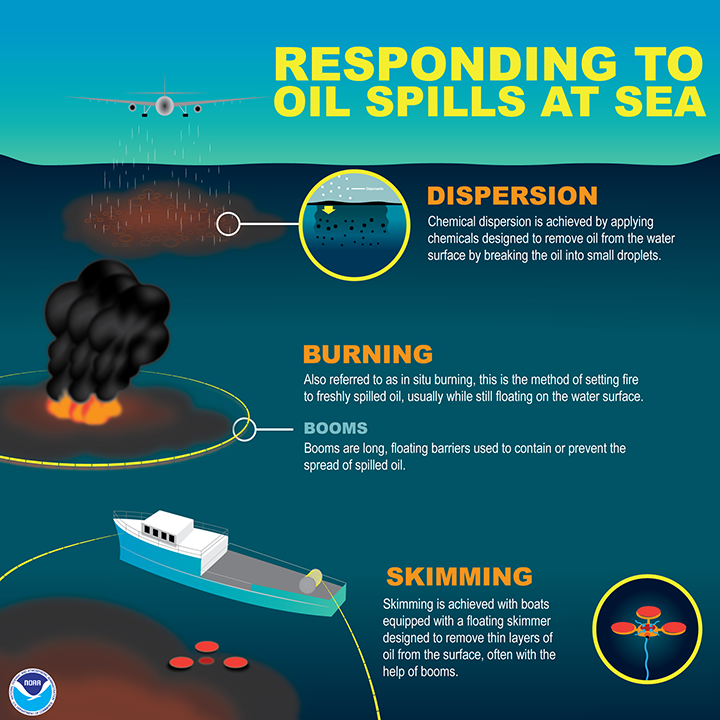How Do Oil Spills out at Sea Typically Get Cleaned Up?
JUNE 17, 2015 -- Whether for hanging a picture on the wall or fixing a leaky faucet, most people keep a common set of tools in their home. While some tools get more use than others, it's good to have an array on hand to handle most repair jobs. The same is true for responding to oil spills.
Like a home repair job, each oil spill has unique aspects that call for careful consideration when deciding which tool to use. Responders keep an array of response methods in their toolkit for dealing with oil in offshore waters: skimming and booming, in situ burning, and applying dispersants.
Let's get to know a few of those tools and the situations when they might be the most appropriate method for dealing with oil spills out at sea.
Skimming: Take a Little off the Top
Skimming is a process that removes oil from the sea surface before it reaches sensitive areas along a coastline. Sometimes, two boats will tow a collection boom, allowing oil to concentrate within the boom, where it is then picked up by a "skimmer." From whirring disks to floating drums, skimmers come in various designs but all basically work by removing the oil layer from the surface of the water. These devices attract oil to their surfaces before transferring it to a collection tank, often on a boat. Ideal conditions for skimming are during the day when the oil slick is thick and the ocean surface is fairly calm.
The success of a skimming operation is dependent on something known as the "encounter rate." Much like a vacuum picks up dirt from your carpet, a skimmer has to come in direct contact with the oil in order to remove it from the surface and, even then, it will still pick up some water. That's why responders will often refer to the volume of oil removed via skimming as gallons of an oil-water mixture.
In Situ Burning: Burn After Oiling
In situ burning is the process of burning spilled oil where it is on the ocean (known as "in situ," which is Latin for "on site"). Similar to skimming, two boats will often tow a fire-retardant collection boom to concentrate enough oil to burn. Burning is sometimes also used in treating oiled marshes.
Ideal conditions for in situ burning are daylight with mild or offshore winds and flat seas. The success of burning oil is dependent on corralling a layer of oil thick enough to maintain a sustained burn. Any burn operation includes careful air monitoring to ensure smoke or residue resulting from the burn do not adversely impact people or wildlife.
Chemical Dispersants: Break It Up
Releasing chemical dispersants, usually from a small plane or a response vessel, on an oil slick breaks down the oil into smaller droplets, allowing them to mix more easily into the water column. Smaller droplets of oil become more readily available to microbes that will eat them and break them down into less harmful compounds.
However, using dispersants has its drawbacks, shifting potential impacts to the marine life living in the water column and on the seafloor. Because of this, the decision to chemically disperse oil into the water column is never made lightly. This decision is often made so that much less oil stays at the surface, where it could affect birds and wildlife at the ocean surface and drift onto vulnerable coastal habitat like beaches, wetlands, and tidal flats.
Ideal conditions for chemical dispersion are daylight with mild winds and moderate seas. Chemical dispersion is never done close to the shore, in shallow waters, near coastal communities, or when there is a potential for winds to carry the chemical spray away from its intended target.
Natural dispersion can and does occur when waves at the ocean surface have enough turbulent energy to allow surface oil to mix into the water column. Applying chemical dispersants can expedite this process when there is an imminent threat associated with allowing the oil to stay on the surface.
One Size Does Not Fit All
You may have noticed that each of these tools has one common factor limiting its effectiveness: daylight, or more precisely, visibility. Being able to see the spilled oil, often over large areas of the ocean, is critical to being able to clean it up. That means these tools become ineffective at night, during certain seasons, or in regions where prolonged darkness, fog, or clouds are the norm.
| Sunlight? | Windy? | Rough Seas? | Cold? | Nearshore? | |
|---|---|---|---|---|---|
| Skimming | Yes | Maybe | No | Yes | Yes |
| Burning | Yes | Maybe | No | Yes | No |
| Dispersing | Yes | No | No | Yes | No |
Rough seas can be prohibitive for skimming and burning since these methods rely on calm conditions and collection booms to gather (and keep) oil in one place. High winds can often rule out burning and aerial dispersion as an option.
While these techniques perform best under certain, ideal conditions, responders often have to make do with the variety of conditions going on during an oil spill and can and do use these tools under less-than-ideal conditions. Their effectiveness also depends on factors such as the type or state of the spilled oil or the environment it was spilled in (e.g., sea ice).
Just like your home repairs, the job sometimes calls for a non-traditional tool or creative fix. The continued development of alternative response methods and technologies for cleaning up oil is critical for addressing oil spills in geographic areas or conditions that the traditional toolbox is not equipped to fix.
 An official website of the United States government.
An official website of the United States government. 


